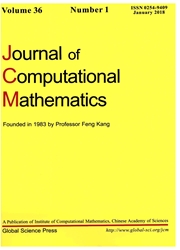

 中文摘要:
中文摘要:
当一套点的坐标被知道时, pairwise 在点之中的欧几里德几何学的距离能容易被计算。相反地,如果欧几里德几何学的距离矩阵被给,为那些点的一套坐标能被计算通过众所周知古典多维的可伸缩(MDS ) 。在这份报纸,我们考虑一些距离远离是精确的盒子(包含的大噪音或平错过) 。处于如此的一种状况,已知的距离的顺序(即,一些距离比其它大) 比就使用已知的距离的大小是经常产出点的更加精确的建设的珍贵信息。使用订购信息的方法一起作为 nonmetric MDS 被知道。在所有存在 nonmetric MDS 方法之中的一个挑战性的计算问题是经常有很多顺序的限制。在这份报纸,我们与顺序的限制作为一个矩阵优化问题扔了这个问题。我们然后改编一存在弄平牛顿方法到我们的矩阵问题。广泛的数字结果表明算法的效率,它能潜在地处理顺序的限制的一个很大的数字。
 英文摘要:
英文摘要:
When the coordinates of a set of points are known, the pairwise Euclidean distances among the points can be easily computed. Conversely, if the Euclidean distance matrix is given, a set of coordinates for those points can be computed through the well known classical Multi-Dimensional Scaling (MDS). In this paper, we consider the case where some of the distances are far from being accurate (containing large noises or even missing). In such a situation, the order of the known distances (i.e., some distances are larger than others) is valuable information that often yields far more accurate construction of the points than just using the magnitude of the known distances. The methods making use of the order information is collectively known as nonmetric MDS. A challenging computational issue among all existing nonmetric MDS methods is that there are often a large number of ordinal constraints. In this paper, we cast this problem as a matrix optimization problem with ordinal constraints. We then adapt an existing smoothing Newton method to our matrix problem. Extensive numerical results demonstrate the efficiency of the algorithm, which can potentially handle a very large number of ordinal constraints.
 同期刊论文项目
同期刊论文项目
 同项目期刊论文
同项目期刊论文
 期刊信息
期刊信息
